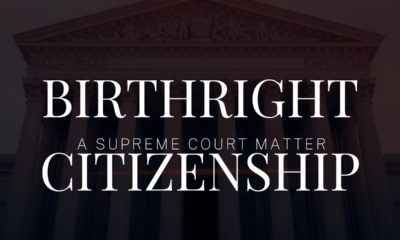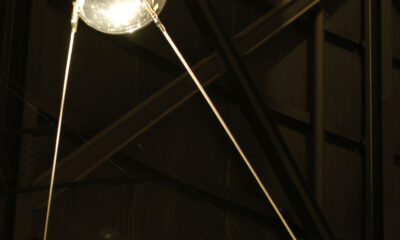Civilization
SpaceX – the game changer
After twenty-two years, SpaceX has earned a stellar reputation – but their design for a Mars city has a crippling flaw they must address.
Twenty-two years ago this month, Elon Musk first conceived of a private company that would, on its own, design rocket ships to travel to Mars. That company, now known as Space Exploration Technologies Corporation, or SpaceX, has revolutionized the space launch industry. Next month it will test, for a third time, its proposed Mars colony ship, Starship. The first two Orbital Flight Tests have both ended in failure, but that poses no great hazard to SpaceX today. The real hazard Musk faces is that his vision of a Mars colony is incomplete, and risks bifurcating the human species into two mutually incompatible groups, with one unable ever to visit Earth. Unless he radically changes his proposed Mars city design, his vision will not create “species life insurance” for humanity. Instead it will lay the basis for a tense relationship, if not war.
SpaceX begins with mockery
The one constant in the history of SpaceX, indeed the influence that spawned the company, is mockery. Elon Musk is a co-founder of PayPal. Late in 2000, the other owners of PayPal threw him out of the company. Happily, he had Buy-Sell agreements with them, so if they wanted him gone, they had to buy him out. Buy him out they did – and left him with $180 million to spend.
He started spending it in funding of various projects – including buying a board seat from the Mars Society for $100,000. This opened up contacts with other engineers, including several working on Project Mars Oasis. That project sought to acquire Martian regolith, transform it into arable soil, and grow a plant in it. To get Martian regolith, the project needed a cheap rocket. So Elon Musk and project engineer James Cantrell traveled to Russia, first in October 2001, then in February 2002. They sought to buy a decommissioned Dnepr ICBM to launch a sample-return probe.
The Russians laughed at the pair, and quoted them a price of $8 million per missile. Musk knew they would gouge him and his friends unmercifully if they paid that price even once. Refusing, Musk and Cantrell departed Russia. On the flight out, Musk conceived of founding his own company to build rockets at far less expense per launch.
SpaceX had its first meeting in a hotel at Los Angeles International Airport. Actual incorporation dates from March 14, 2002.
The secret: reusability
SpaceX solved the expense problem in a way only a geek/nerd could conceive – and only a genius could make real. How much more expensive would air travel be, he reasoned, if, every time Boeing Group or Airbus Industrie built an airliner, they scrapped it after one flight only! So, as much as possible, rockets must be reusable. For six years the company spent Elon Musk’s millions on development of new rocket engines, then of a booster stage that could actually return to Earth for a landing. SpaceX also developed a new capsule, the Dragon, that could fly several missions after nominal refurbishing.
Starting in 2008, SpaceX and NASA each effectively saved the other. NASA provided critical funding for the eventual development of Falcon 9, the first rocket with a reusable booster. Then in 2010, SpaceX sent a Dragon into orbit and retrieved it after two orbits. It could only carry cargo, but that would prove vital – because the Space Shuttle fleet formally retired in 2011. In that same year, NASA paid SpaceX $75 million to redesign Dragon with a proper launch-escape system.
SpaceX began launching “Cargo Dragons” in 2012, while continuing to work on the Dragon redesign. In 2020, its efforts paid off, when the first “Crew Dragon” successfully delivered astronauts to the International Space Station, and brought them back to Earth. With that mission, RosKosmos, the Russian space agency, lost its monopoly on launching and returning astronauts.
Milestone after milestone
Those achievements would be breathtaking enough. But reusable rockets have let SpaceX launch payloads – and crew – at far less cost than anyone else can manage. Today the company offers launches on two kinds of rocket. Falcon 9 takes up middle-weight payloads – or, through the company’s “Ride Share” program, collections of lightweight payloads. Falcon Heavy – with three boosters – take up heavier payloads.
At first, every launch of a Falcon 9 had an element of suspense: would it, or would it not, land safely? To make such launches more interesting, the company started landing Falcon 9 boosters on robotic barges. Today, those safe landings are almost as routine as are landings of commercial airliners. At present only the second Falcon stage, or the central core stage of a Falcon Heavy, remains expendable.
SpaceX even recovers the fairing – the conical shroud that forms a rocket ship’s nose and protects the payload before the ship leaves the atmosphere. Those parts cost money – big money – and SpaceX doesn’t like to waste them. As a side benefit, the company isn’t polluting or littering the ocean with discarded boosters and fairing halves. (Second stages generally are moving so fast that, if they fall back to Earth, they burn up. The same holds for Falcon Heavy core stages – though SpaceX has conceived of a method of recovering that, also.)
SpaceX builds a mega-lifter
But the company has never forgotten its real reason for being: to plant a sustainable colony on Mars. Elon Musk chose Mars because, of all the planets in the Solar system, it is the most hospitable – other than Earth itself. That doesn’t say much, but it is no less true. Mercury has no atmosphere, so its surface is subject to tremendous extremes of heat and cold. Venus has a crushing atmosphere. At least one engineer has proposed building a city for Venus – and suspending it in mid-air, with gas-filled balloons. At 30,000 feet, the atmosphere would almost be breathable – if not for its sulfur dioxide content. But that atmosphere has crushed every probe that has parachuted to the planet’s surface.
But SpaceX proposes a space city on the surface, and Mars offers the best compromise. So from the beginning, Elon Musk has sought to develop a rocket to deliver crew, equipment and supplies to Mars, and return to Earth. That rocket is Starship. One can think of it as an interplanetary Conestoga wagon – especially since SpaceX plans sending fleets of Starships to Mars. Those fleets would be the wagon trains of our modern age.
Starship will have everything one could want in a heavy lifter with minimal cost-to-mass. Literal tankers will refuel those rockets after they reach space, enabling them to get to Mars. And on Mars, crews will use components of the local atmosphere to make fuel for the return trip.
Low gravity as boon – and bane
But the SpaceX vision has one problem that they have not thought through. Mars is smaller than Earth – and the smaller a planet, the less its gravity. In fact, surface gravity varies directly as a body’s radius, and the mass density of its average substance. For the same reason, so does escape speed from the surface. For all those reasons, surface gravity on Mars, and escape speed from its surface, are 37% of their Earth values.
The 63% weight savings makes the difference between success and failure of round trips to Mars. One does not build boosters on Mars – nor does one need them.
But surface gravity is another matter. It’s all very well to observe that you can lift objects three times as heavy on Mars than on Earth. True – for the first generation. But crew staying on Mars long-term will start to lose muscle mass from the first day. Doctors have seen it happen to astronauts aboard the Space Station. Not even the station’s gymnasium, with its spring-loaded resistance exercisers, can forestall this. Astronauts lose not only muscle but bone also – and they don’t get it all back.
Doctors know all this. They worry that a crew going to Mars and staying there, will eventually not be able to return to Earth. And that’s only the first generation! Succeeding generations will develop long, lean – and delicate – bodies. God designed humans for Earth-standard gravity, and that’s what they need.
The civil engineering problem
SpaceX offers little but an artist’s concept drawing of a city on Mars, but that drawing speaks volumes. It depicts humans, of typical proportions, watching Starships take off from the safety of transparent domes. If any of the company’s engineers has thought through the long-term health implications of living in little-more-than-one-third gravity, the company gives no sign. That human family, again, will be long, lean, brittle, and not even recognizable as human. Its members – especially the two children – will suffer from claustrophobia.
Elon Musk has the right basic concept – that a city in space must be self-sustaining. But the planned execution is seriously flawed, if anyone at SpaceX has a plan at all. Again: successive generations of colonists would lose any ability of the original crew to “lift heavy things and bound around.”
No doubt the colony would be self-sustaining, because Mars has abundances of the necessities for life – even ice. But the colonists would never be able to return safely to Earth. Robert A. Heinlein depicted this for an even lighter-gravity environment, namely the Moon – in The Moon is a Harsh Mistress. Mars might not be a harsh mistress, but it would be a jealous one.
And that would create a tremendous social problem. For the first time, humanity would exist as two populations, incompatible for procreation. The difference between Earthers and “Martians” would be worse than interracial – they would be interspecial. Loss of common bonds is one way to start wars. Ask the Russians and the Ukrainians.
A nearly forgotten solution
Long ago, another visionary conceived of an even more fanciful project: building a vessel similar to Star Trek’s iconic spacecraft. That site exists only on the Wayback Machine today, but that archive has all the original proposed design elements and mission profiles. Two of them involved missions to Mars:
- To deliver massive numbers of rovers and specially designed aircraft, including even fixed-wing aircraft, and then:
- To build a permanent base on Mars.
This visionary knew that humans live and work best in Earth-standard gravity. So he proposed building the entire base as a gigantic beveled centrifuge. It would spin fast enough to simulate standard gravity. Furthermore, it would have an angle calculated so that anyone on board could orient himself to “up” and “down” easily. This solution is available for colonizing Mars or the Moon. One need only adjust the size, spin rate, and bevel angle. This solution affords Earth-standard gravity on any body smaller than Earth.
So the ideal Martian city is either one beveled centrifuge, or several, with a transportation network to correct them. Then the colonists would spend most of their time aboard one of these centrifuges – and still “work out.” The larger the centrifuge, the slower it need spin – and the less one risks claustrophobia.
The practical application
So let the colonists save the low-gravity routine for:
- Their spaceport (the most obvious application),
- Their vegetable garden (for growing much larger vegetables than one can grow on Earth), and:
- A hospital specializing in cardio-pulmonary and cardio-vascular medicine and surgery.
The maternity hospital, and the physical medicine and rehabilitation center, must stay on the centrifuge. Gravity plays an integral role during pregnancy, labor-and-delivery, and healing of broken bones.
Let SpaceX make this refinement, and their proposed Mars city will work. Mars is an ideal stage for asteroid mining, besides being the hypothetical refuge Elon Musk envisions.
The company will make its third attempt to send its space-borne Conestoga wagon into orbit next month.
Terry A. Hurlbut has been a student of politics, philosophy, and science for more than 35 years. He is a graduate of Yale College and has served as a physician-level laboratory administrator in a 250-bed community hospital. He also is a serious student of the Bible, is conversant in its two primary original languages, and has followed the creation-science movement closely since 1993.
-

 Civilization5 days ago
Civilization5 days agoOn the 2025 National Security Strategy
-

 Civilization3 days ago
Civilization3 days agoIvory Tower Thinking and Narcotics Boats
-

 Executive2 days ago
Executive2 days agoThe Last Supper: New York’s Socialist Feast
-

 Executive4 days ago
Executive4 days agoWaste of the Day: Shockingly, Inmate Phone Calls Lead to More Criminal Activity
-

 Civilization2 days ago
Civilization2 days agoYoo Hoo, VP Vance—Your Character is Showing!
-

 Executive4 days ago
Executive4 days agoWH Ignores Demands From Pro Life Lobby To Fire FDA Commissioner
-

 Civilization5 days ago
Civilization5 days agoIf Not a Musk, Then the Navy Needs Another Rickover
-

 Civilization4 days ago
Civilization4 days agoGeneral Misconduct: There Is an ‘I’ in Milley














